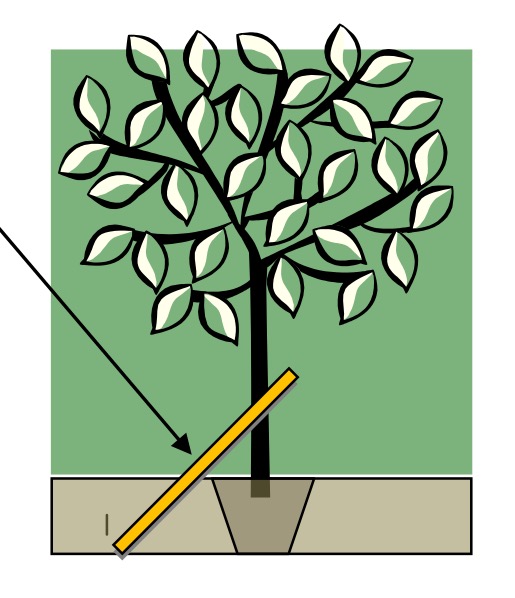It is important that a few key steps are taken at planting time to help your tree establish quickly and grow well.
Prepare the Ground.
Ensure that the ground is prepared properly. It takes a bit of work but is well worth it.
The hole that you dig will need to be twice as wide as the root ball of the tree. Fork over the ground at the bottom of the hole and blend in some Bone Meal fertiliser. This is a good organic slow release fertiliser. Other fertilisers such as Growmore could also be used.
The soil that you take out of the hole should be enriched with plenty of organic matter, we recommend the use of a tree and shrub planting compost. This is good for the release of nutrients later on and helps with water retention.
Water the tree thoroughly before planting.
If it is very dry, stand it in a bucket of water until the compost is moist throughout.
If when you take the pot off, the roots are congested, tease them out to encourage them to grow into the surrounding soil.
When you place the tree in the prepared hole, make sure that it isn’t any deeper than it was in the pot (or ground if planting bareroot / rootballed trees). If it is planted lower, the trunk which was previously exposed will now be buried. Trees take in oxygen from around the bottom of the trunk, and covering it will cause the tree to suffocate, and it will eventually die.
As you refill the hole around the tree, firm the soil down as you go to prevent air pockets. Roots will not grow into air pockets.
Use a solid tree stake.
The most important point is to stake your tree. The stake that you put in will need to be there for about two years whilst the tree establishes a good root system, so the cane in the pot won’t be enough.
The reason for the stake isn’t to stop the tree blowing in the wind, it is important that it does this in order to strengthen the trunk. The stake is primarily there to stop the root ball moving in the ground every time the wind blows. If this is allowed to happen, the new roots will break and the tree is unable to put roots out into the surrounding soil and it won’t thrive.

When putting the stake in, put it in at a 45° angle to the tree, and if possible, into the prevailing wind (usually South West). Putting the stake in at an angle means that the roots are not damaged when the stake is driven into the ground. A rubber tree tie should be used. Secure the tree to the stake with a rubber tree tie. To prevent the stake from chafing the bark use a tie with a spacer. A rubber tie will allow the trunk to expand as the tree grows and won’t dig in to the tree.
Watering
Water in thoroughly and apply a mulch around the tree (tree and shrub compost can also be used for this) to conserve moisture where the roots will be developing.
It is difficult to give hard and fast rules regarding watering. It depends on the season when the tree is planted, the soil it is planted in and the size of the tree.
If you are planting in the autumn, less frequent watering is required as the tree is approaching winter dormancy. You must water the tree in well at the time of planting, and if the ground is dry, continue to water weekly until leaf fall. Over winter the tree is dormant and watering will not be required. Keep a close eye on it in the spring though. If the season is dry you will need to water as often as is necessary until the tree is established.
Overwatering is brought about by watering little and often. You cannot overwater in one watering, so it is better to give a thorough watering say once a week, than a little bit every day.
The fact that the tree is in the ground will retain a degree of moisture, and the tree will require less water than if it were in a pot.
Tree Ties; Stakes and mulches are all available at the nursery, and are the ones we use and recommend for good establishment.
